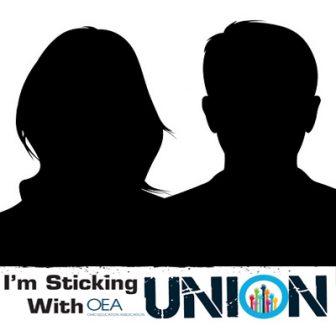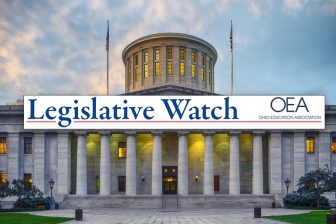Action Alert: Ohio Education Association Urges Members to Call on Congress to Provide Critical Funding for Schools
“Communities across the country are hurting. More than a million Ohioans are out of work. We know lawmakers at every level have to make very difficult choices, but education must remain a priority and Congress must act now,” OEA President Scott DiMauro said.
The financial plight of Ohio’s schools has garnered national attention and DiMauro has been asked to speak on a national telephone town hall, sponsored by the National Education Association, on Thursday, May 14, 2020 at 7 p.m. with NEA President Lily Eskelsen Garcia, CA Senator Kamala Harris and CT Congresswoman Jahana Hayes, a former national teacher of the year. The event is intended to mobilize the nation’s educators to contact Congress.
Anyone who wishes to participate can register for the event at nea.org/actiontownhall.
OEA members are calling on Congress to earmark $175 billion for education in the next federal coronavirus relief package to help mitigate the harm to students caused by budget cuts at the state and local levels. That funding is urgently needed in Ohio, particularly in the wake of Governor DeWine’s intention to cut $465 million in education funding in the current fiscal year which ends in June.
“Teachers have been heroic in their efforts to engage and educate their students while schools are closed, but there are tremendous challenges,” DiMauro said. “Many families don’t have internet access or enough devices for their children; many parents can’t help their children through the school day because they are frontline workers who must be out of the home. The challenges are especially great in the state’s poorer school districts,” he explained.
The OEA, Ohio’s largest teachers’ union, has been in touch with the offices of Ohio Senators Brown and Portman to urge their support for federal action. “Only the federal government has the resources to stabilize education funding in the country right now. Our federal lawmakers have a duty to provide the funding our kids need,” DiMauro said.
OEA members can contact their representatives in Congress at https://www.ohea.org/actions/action-alert-april-14/
OEA represents 122,000 teachers, faculty members and support professionals who work in Ohio’s schools, colleges, and universities to help improve public education and the lives of Ohio’s children. OEA members provide professional services to benefit students, schools and the public in virtually every position needed to run Ohio’s schools.
Conference Committee Testimony by Dan Heintz
By Dan Heintz, Chardon LSD
Distinguished members of Ohio’s 133rd General Assembly,
 My name is Dan Heintz. I am happy to share that I am a K-12 product of Ohio’s great public schools. I am also proud to say that I am a public school teacher at Chardon High School. Finally, I am honored to serve my neighbors as a member of the Cleveland Heights – University Heights Board of Education. As you can see my friends, public education flows through my veins and animates my spirit.
My name is Dan Heintz. I am happy to share that I am a K-12 product of Ohio’s great public schools. I am also proud to say that I am a public school teacher at Chardon High School. Finally, I am honored to serve my neighbors as a member of the Cleveland Heights – University Heights Board of Education. As you can see my friends, public education flows through my veins and animates my spirit.
Our Cleveland Heights – University Heights Schools have suffered under the burden of EdChoice in a way that few other districts have. Currently, 33% of our state funds are being diverted as a result of EdChoice. Our schools have fallen victim to a well-intentioned, but poorly conceived cult of accountability. Nowhere perhaps are these measures more inappropriately punitive than in Cleveland Heights – University Heights.
Cleveland Heights High School is an EdChoice school for one reason: Graduation Rate. Given this, one would expect our graduation rate to be low. It’s not. For the past 2 years in fact, our graduation rate has been higher than the state average, yet the state’s formula has nonetheless labeled ours as an underperforming EdChoice High School.
The College Board is the non-profit organization behind the SAT test, as well as all of the Advanced Placement coursework that many of our students take advantage of. Distinguished members of the General Assembly, four weeks ago, The College Board identified nine Ohio High Schools as AP Honor Roll High Schools. Cleveland Heights High School, labeled by the State as EdChoice eligible school, was one of these nine.
So, contrary to the State of Ohio’s label, the College Board doesn’t seem to think that ours is an underperforming high school at all, but what do America’s colleges and universities think? Are they confident that the graduates of Cleveland Heights High are prepared for success? You bet they are, and they put their money where their mouth is. My friends, Cleveland Heights High’s class of 2018 was offered a combined 10.4 million dollars of college scholarships. 10.4 million dollars. And the class of 2019 beat them! Our class of 2019 (roughly 350 students) was offered 12.1 million dollars in scholarship offers.
So, our graduation rate is above the state average, The College Board identifies us as an AP Honor Roll School, and our grads pulled in over 22 million dollars in scholarship offers over the past 2 years. But our own state government has determined that this is such a disappointing school that we need to provide a financial escape hatch in order for students to attend a private school. I simply cannot imagine that this is what we had in mind as the EdChoice system was being designed.
The pundits tell us that vouchers improve education by introducing competition. The narrative they promote is that families use vouchers to leave low performing public schools in order to attend higher-performing private schools. This narrative is pure sophistry. Facts are stubborn things, and the facts simply don’t support the narrative.
First, the overwhelming majority of our EdChoice voucher recipients are not leaving our schools at all, because leaving our schools would require them to have entered them in the first place. Committee members, 94% of our EdChoice vouchers are being used by students who have never been enrolled in one of our public schools. 94%. Furthermore, the private schools that receive this windfall of Ohio tax dollars are not always higher performing. According to the Ohio Department of Education, 61 of our students use EdChoice vouchers to attend a school whose 5th grade scores are lower than those of our district. That’s nearly a quarter of a million dollars! So let’s be clear, these people are not running from a failing school, they’re running from a tuition bill. Again, I cannot imagine that this is what we had in mind as the EdChoice system was being designed.
Ladies and gentlemen, my two-part request very simple: First, please rethink how we measure our public schools. And as you think that over, please come visit Cleveland Heights High. Second, if vouchers are to remain in the mix, please fund them directly from the state’s operating budget. The work that districts like mine do is hard enough without the additional challenges of depleted state aid.
Committee members, I thank you for your service to our state, and for your time today. If you have any questions, I am at your service.
— Dan Heintz is a Social Studies teacher at Chardon High School, Chardon, Ohio.
Legislative Testimony on HB 70 — State Takeover Law
![]() [Click here print a copy | Click here to send a letter to your Ohio Senator]
[Click here print a copy | Click here to send a letter to your Ohio Senator]
Chair Lehner and members of the Senate Education Committee, my name is Scott DiMauro. I am currently in my 29th year in education, including 16 years in the classroom as a high school social studies teacher, and currently serve as the president of the Ohio Education Association (OEA).
On behalf of the OEA’s 123,000 members, thank you for this opportunity to provide feedback on the Senate’s substitute bill for HB 154.
The draft bill under consideration makes a variety of proposals intended to address ongoing problems with the Ohio law (HB 70 131st G.A.) authorizing state takeovers of local school districts.
This testimony will highlight specific feedback and recommendations regarding the draft bill. However, this does not represent a comprehensive outline of all issues and concerns raised by OEA in a previous letter to the Chair (dated August 29, 2019).
Although OEA opposes the current draft bill, we acknowledge the stakeholder feedback process is ongoing and the final product is a work in progress.
OEA looks forward to working with the Ohio General Assembly to find common ground in solving the fundamental problems presented by Ohio’s state takeover law.
To that end, OEA is hopeful that our constructive feedback to policy makers can facilitate the identification of problems with the state takeover law and the development of real solutions. We appreciate the Chair’s commitment to a non-punitive school improvement framework that depends on local control and stakeholder buy-in, acknowledges the time needed for meaningful improvement, and recognizes the need for flexibility in ensuring that each community’s improvement plan reflects the unique needs of that community.
The major shortcoming of the draft bill continues to be the lack of checks-and-balances.
Our focus in providing feedback is two-fold: First, to help all students in challenging learning environments overcome these barriers and become life-long learners. Second, to support the work of front-line educators serving students in especially challenging learning environments.
Classroom teachers are the front-line educators in our public schools. Our service to students is benefited greatly when we have support and collaboration from others who share our commitment to the success of our students, including parents, education support professionals, principals, administrators, and locally-elected school boards.
As an overview to the following OEA feedback, the current draft bill contains some positive elements and constructive concepts that can serve as a foundation for improvement with continued stakeholder input.
However, the major shortcoming of the draft bill continues to be the lack of checks-and-balances to the unilateral authority granted to the Director of the School Improvement Commission. The Director and School Improvement Committee would replace the Chief Executive Officer (CEO) and Academic Distress Committee (ADC) that exist in current law. The recommendations below are intended to address this fundamental flaw in Ohio’s state takeover law and the current draft bill.
OEA recommendations:
1) Return local control to school districts and communities currently under the control of an Academic Distress Commission/CEO before the 2020-2021 school year.
- Local control and community oversight play a fundamental role in both the operation and funding of public schools in Ohio. Those closest to students are in the best position to understand and assess the needs of the students in any given community. State takeovers break this system of local control and citizen-based accountability.
- OEA proposes to amend the ADC dissolution process in the draft bill to require the School Transformation Board (STB) to approve terms for a district’s petition for dissolution and a transition to local control before the 2020-2021 school year. The current draft bill only allows current ADC districts to petition for dissolution between February 15, 2020 and June 30, 2020, and there is no guarantee of a return to local control. Therefore, it remains unclear whether, or when, the current ADC districts will be released from the problems of state control.
- OEA also proposes to automatically dissolve the current ADCs and provide these districts the same report card “restart” on the state takeover clock that all other districts would receive under the draft bill. By treating current ADC districts equally with all other districts, they will have the same fair opportunity to start fresh under whatever state takeover framework the General Assembly ultimately approves.
2) Return all collective bargaining rights taken away under the current state takeover law (HB 70; 131st).
- State takeover laws do not create a school improvement environment by taking away educators’ collective bargaining rights. Removing bargaining rights is a punitive and counterproductive measure that undermines school improvement. Effective school improvement actions taken by the General Assembly should support educators, not punish them. However, the draft bill aggravates this situation by taking bargaining rights away even faster than under HB 70. This is a mistake.
- The removal of bargaining rights by the current state takeover law and the draft bill is a fundamental flaw that is based on false assumptions about the role of collective bargaining in school improvement. Teachers and education support professionals use the collective bargaining process as their formal voice to petition school district leaders for the kinds of supports they know will help them serve students in the classroom. Collective bargaining rights provide educators a necessary opportunity to advocate for their student’s needs, which is even more critical in districts that have especially challenging learning environments.
- School leaders and decision makers also benefit from collective bargaining because they provide an important feedback mechanism to support district-wide collaboration around school improvement. A state takeover law that removes teacher collective bargaining rights will fail. School districts that receive an “A” rating on Ohio’s report cards also have collective bargaining agreements. These important rights should be maintained and protected in all school districts.
- OEA also proposes to remove district board policies and collective bargaining agreements as one of the factors to be included in a root cause analysis under Section 3301.283 of the bill. Collective bargaining is not the reason why some schools perform below expectations. The bill wisely requires an analysis of factors that may include leadership, governance, and communication; curriculum and instruction; assessment and effective use of student data; human resources and professional development; student supports; fiscal management; or other issues preventing full or high-quality implementation of improvement plans. If a root cause analysis identifies one of these issues and it is covered in a collective bargaining agreement, OEA believes it is appropriate for management and the union to address the issue at the bargaining table.
3) Increase and strengthen teacher membership on the School Transformation Board (STB) and the School Improvement Committee (SIC).
Input and feedback from active front-line educators will improve and inform the work of the STB and SIC as they seek to understand the barriers to learning faced by children living in poverty. Ensuring a meaningful role and a formal voice for at least one teacher on the STB and SIC will provide an important resource to these entities. This is in the interest of the students we are trying to help.
- OEA proposes that membership on the School Transformation Board should include at least one active teacher member (currently there is no active teacher member).
- OEA also proposes that the active teacher member on the SIC should have voting rights. The draft bill requires one teacher member on the SIC, but without voting rights. (Note that under current law, the designated educator member of an Academic Distress Commission does have voting rights.) The role and authority of the SIC should also be expanded, relative to the broad unilateral powers granted to the SIC Director.
In closing, thank you for engaging stakeholders in this important legislative effort to serve students by resolving problems and flaws with Ohio’s state takeover law.
Any successful legislation will reflect a recognition that state takeovers are an inherently ineffective and inefficient policy model for collaborative school improvement.
Again, thank you for this opportunity to testify. I am available for any question the Chair or the committee members may have.
Thank you.
Keep House-passed Language on Repealing Flawed State Takeover Law
Wednesday, May 29, 2019, before the Ohio Senate Education Committee, Ohio Education Association (OEA) President Becky Higgins called on legislators to keep the provisions of House Bill 154 that were included in the state budget recently passed by the House.
“We urge the Senate to keep the language in the House-passed budget that is part of HB 154 and that would do away with state-mandated Academic Distress Commissions.” — OEA President Becky Higgins
 “There is widespread agreement – among educators, local officials and state lawmakers of both parties, that the law (HB 70) mandating the state takeover of troubled school districts is flawed and needs to be replaced,” said Higgins.
“There is widespread agreement – among educators, local officials and state lawmakers of both parties, that the law (HB 70) mandating the state takeover of troubled school districts is flawed and needs to be replaced,” said Higgins.
“We very much like the approach taken by HB 154, which would repeal HB 70 and restore local control and which recently passed the House with strong bipartisan support (83-12). We urge the Senate to keep the language in the House-passed budget that is part of HB 154 and that would do away with state-mandated Academic Distress Commissions.”
Higgins also added, “we recognize that other approaches are being offered to address the problems that plague troubled schools in our state. Whatever the eventual agreed-upon plan looks like, we believe strongly that it should include a role for educators who well understand the needs of their students and what it will take to improve student performance.
In short, we don’t need state mandates. It’s time to restore local control of our schools. We look forward to working with Senator Lehner and members of the Senate Education Committee on a viable alternative to the current fatally-flawed state takeover law.”
![]()
Why I Ran for Office
OEA Guest Blog | By Molly Wassmuth (Westerville EA), Central FCPE PAC and Grandview Heights School Board member
 I can remember back to the 2016 presidential election.
I can remember back to the 2016 presidential election.
That election did not turn out the way I had hoped or worked for, despite the fact that I donated, canvassed and phone-banked. I can remember thinking that I need to do more.
During this time, I was in the Central OEA/NEA Emerging Leaders Program, and talking with fellow member Billie Sarich about the school district where we live. I asked her, “Hey, when are the elections for school board?” She told me three seats were up for election and she immediately asked, “Are you thinking about it?” Maybe….
Over the next month, I wondered if I could run? I realized my feelings of self-doubt about not being a typical candidate were the exact reasons I should run.
What school board and community doesn’t need a slightly overzealous parent with a strong union background and an educator’s knowledge, experience, and support? I can thank OEA for that support — for helping me plan, connecting me with Franklin County Democrats, suggesting campaign training and helping me to connect to state representatives Kristin Boggs and Adam Miller.
I realized my feelings of self-doubt about not being a typical candidate were the exact reasons I should run.
I have learned so much during the process of running and being elected. I learned how to campaign, how to turn a no vote into a yes vote and how important help and support are. I have learned to not give up on an idea or let someone talk over me. Being newly elected, I got a fair amount of “this is how it is” and the question of “why?” may have been overlooked. It took me about four months to get over waiting for my voice to be heard or respected. I had to find my good ole teacher voice and make myself heard.
Now, from my new perspective, I wish everyone knew from my perspective, I wish more people attended meetings and speak up. Be daring and invite a board member to your classroom to see how an initiative is playing out. Go to a board meeting and let members know how a policy is or is not working. Show them how things are going. I would bet you my hard-earned salary that they would show up and try to help!
Board members and other elected officials do not know what they do not know. They can depend on their constituents to give them perspective on issues. So, I encourage all of you to educate, raise awareness, and be heard.
[ RELATED: Ohio School Boards – Why They Matter ]![]()
Former OEA Members Working to Dismantle State Takeover Law
State Representatives Joseph A. Miller III (D-Amherst) and Don Jones (R-Freeport) recently announced they will soon introduce bipartisan legislation to repeal portions of House Bill 70 — the state takeover bill.
Rep. Miller, who taught social studies at Firelands High School — and a member of Firelands E.A. / OEA — before being elected to the Ohio House, said the proposal would dissolve the Academic Distress Commissions that have “been unable to work effectively alongside the district’s teachers, school leaders and community.” He also added the proposed legislation would “give struggling schools the support they need to succeed.”
“The Academic Distress Commissions have been unable to work effectively alongside the district’s teachers…”
Rep. Jones, the pending legislation’s co-sponsor, is also an educator. Before being elected to the Ohio House, Jones was an agricultural education teacher and FFA∗ advisor at Harrison Central High School — and a member of the Harrison Hill T.A./OEA — for 23 years. In the statement announcing the proposed legislation, Jones said that Ohio schools “need more local control — not less.”
Ohio schools “need more local control — not less.”
The 2015 legislation currently requires the state superintendent to intervene via “Academic Distress Commissions” for any school district declared to be in “Academic Emergency.” Placed under state-control, the commission assumes the decision-making authority of the locally-elected school board. It also hires a CEO with broad powers to run the district, overruling the local school board’s appointed superintendent.
Miller and Jones are currently seeking additional legislative sponsors and are expected to introduce a formal bill soon. Their initiative has the support of the OEA.
∗Future Farmers of America
Related Stories
- State Takeover: OEA Comment to the Ohio State Board of Education | By Scott DiMauro, OEA Vice President
- 03.13.2019 | Columbus Dispatch: Legislators show growing opposition to state takeovers
- 03.13.2019 | Despite critique from business leaders, state school broadens road to diploma
Praise For Governor’s State of the State Address
(COLUMBUS, OH, MARCH 5, 2019)
Ohio Education Association President Becky Higgins today offered warm words for Governor Mike DeWine’s first state of the state address.
“It is clear from his speech that Governor DeWine cares about Ohio’s children and is ready to do what it takes to support our students,” said OEA President Becky Higgins.
“I want to thank the Governor for his recognition of Ohio’s dedicated teachers and the important role they play in the lives of their students. Too often, this is left unsaid by state leaders.”
“OEA members share the Governor’s commitment to expanding early childhood education, wrap-around services and providing additional resources to meet student needs.”
Higgins also added: “We look forward to working with the Governor and state legislators to achieve these shared goals.”
VIDEO: 2019 State of the State Address — Courtesy of ideastream®
![]()
The Ohio Education Association represents 122,000 teachers, faculty members and support professionals in Ohio’s public schools, colleges and universities. Click here to learn more about the Ohio Education Association.
The School Report Card Sham
By Kevin Griffin of the @DublinEA/OEA
The state report cards have been around for several years. Their erroneous grades and convoluted metrics have been so well documented, that educationally, they are about as relevant as Kardashian reruns. It’s unfortunate that districts now need to deal with the annual damage control when they are released.
The real victims are our students.

It’s important for us to remember why these report cards were conceived. It was, quite simply, to make us look bad. The corporate reformers, with help from ALEC, created standardized testing, value-added, and then the report cards, as a way to convince the public their schools were failing. The public didn’t buy it.
But don’t count on the vultures to fly away when there’s money to be made. Despite the fact the legislature knows the report cards are full of problems and half-truths, they are still being used to shut districts down, a thought inconceivable not too long ago.
“But don’t count on the vultures to fly away when there’s money to be made.”
HB 70 uses the report card data to dismantle the school board and replace administrators with a CEO who can basically do whatever he wants. Youngstown and Lorain Schools have already been taken over, East Cleveland is in the process, and Dayton Schools is next in line. The slow, but steady process to turn every school in these areas into a charter school has begun.
The real victims are our students. The one thing the report card does show is an undeniable link between test scores and poverty. In fact, Ohio’s lowest performing districts, those with a performance score under 70, have eight times the number of low-income students as districts with a performance score of 100.
So now these students, the ones who need more support, stability, and love than all the others, will be transported to for-profit charter schools. And we all know how well that works out.
Kevin Griffin is a member of the @DublinEA and the Central OEA Vice President
This post originally appeared in the in Winter 2019 issue of the Communique, a publication of the Central OEA/NEA
![]()
Click here for more #OverTestedOH & #RedForEd Voices and How to Make a Stand
Blog: The Antidote to Despair
By Julie Rine is an English Instructor and an Academic Challenge Advisor at Minerva High School, Minerva, Ohio.
 It’s easy to feel hopeless and overwhelmed right now, isn’t it? The Supreme Court’s decision regarding the Janus case, while not unexpected, still stung. The move by the Court has the potential to weaken unions, many sources say, and the decision has even been referred to as a “crippling blow” .
It’s easy to feel hopeless and overwhelmed right now, isn’t it? The Supreme Court’s decision regarding the Janus case, while not unexpected, still stung. The move by the Court has the potential to weaken unions, many sources say, and the decision has even been referred to as a “crippling blow” .
There are certain unfortunate situations in life that we can’t control, and it’s important to recognize those and let them go rather than devote energy to a state of affairs that cannot be changed.
There are also situations in life that we CAN impact, with our actions, our words, our advocacy, but even in those situations, there are moments when you have to let go, politically, personally, emotionally. You have to take a break, look away, check out, turn off the news and turn on a Friends rerun, lose yourself in a good book, take a few deep breaths and decide to let go and let someone else take up the cause for awhile. Those “let go” moments are critical to maintaining good mental health and restoring energy to jump back into the fray when we are refreshed and ready to go.
But this is not one of those times. This is not a “let go” moment. This is a “Let’s Go” moment.
The media would have you believe that the Janus ruling will lead to fewer union members which means a reduction in funds which equals unions cutting jobs and services and benefits. If you believe the news, soon our teacher unions will be so weak and ineffective that teachers will not be able to influence an impressionable kindergartner, let alone legislative policies.
Don’t believe the hype.
If anyone is equipped to turn a bad roll of the dice into an opportunity to change the game, it’s teachers.
On a daily and weekly basis, we think on our feet, we adapt to a snag in the routine. We reflect on what worked and what didn’t and make adjustments in the three minutes between classes, a task that would take Congress three months. We take on whatever challenges exist in our communities and in our classrooms and we overcome them. We don’t stop there, either. Most of the time, we not only overcome the challenges we face, challenges which can change from year to year and week to week, (sometimes even minute to minute!), we create new programs, new methods, and new realities that are often more effective for our students than what existed before the obstacle presented itself.
I don’t care what your political leanings are, if you are a teacher, you rival only parents in your fierce desire to protect kids and prepare them to succeed in the future.
The union helps us do just that. Through the union, we can fight for what our kids need to succeed, such as smaller class sizes, adequate and up-to-date academic resources, onsite counselors and mental health professionals, and a safe environment in which to learn. The union also helps us fight for what teachers need to help students succeed, such as adequate planning time, meaningful professional development, continued opportunities for further education and training, sufficient time to work as teams to tackle problems rather than as isolated instructors behind our classroom doors, and yes, a fair salary which allows us to focus fully on our students and our own families instead of squeezing in hours away from both while we work a second job to make ends meet. The trickle-down effect here is obvious; when teachers lack support and resources, kids lose the effective education they deserve.
So what can we do?
The decision will not be reversed, and even worse, it appears that a new Justice will be seated who may have equally damaging views of unions and public education.
First, we must remember that Supreme Court Justices are not the only ones allowed to issue opinions. We can write letters to the editor of our local papers, and we can routinely call or write our elected officials to make our voices heard and our opinions known.
Secondly, we can actively recruit members, especially young teachers, to not only join the union, but to become active in the union. Retaining or gaining members will of course help the union financially, since our dues dollars provide us with the resources and training necessary to be effective advocates for our students. But we don’t just need the dues money. We need active and energetic members, more than ever before. Money talks, but members act.
Thirdly, we can help register new voters. If we want a future in which citizens are active participants in the democratic process (whether they are on “our side” or not), then we must emphasize the importance and value of our right to vote, and then take the practical step to register young voters. It is a simple process. There is no reason why every 18-year-old student who graduates from an American high school should not be registered to vote.
 We can’t force them to register, however, so the goal should be to get them excited to register.
We can’t force them to register, however, so the goal should be to get them excited to register.
By teaching our students how to read a variety of sources on any given topic and then to form their own opinion, we help them become critical thinkers. Critical thinkers are often eager to make their positions known, and the most powerful way to do that is to exercise the right to vote. Few moments of my teaching career have been as special to me as when I registered a student to vote and she literally high-fived me and yelled, “I can vote, I can vote!” This is the enthusiasm we must seek to engender in our classrooms.
Perhaps most importantly, we can get involved in local and OEA efforts to elect pro-public education and pro-union candidates. We can work phone banks, canvass door-to-door, talk to our colleagues and friends about why we support certain candidates. We must follow that up by voting for candidates who support us as public school teachers and as union members, up and down the ballot, in local elections, in primaries, in midterms and in presidential elections. These actions are particularly important in Ohio this year, as we will be voting for a senator and a governor.
Political defeats can be discouraging, but nothing feels worse than knowing you could have done more to ensure victory when instead you chose to sit on the sidelines. We must take our frustration and allow it to motivate us to take action.
Sure, the Supreme Court decision is a setback, a challenge to be overcome. But a “blow” to unions? I don’t think so. In fact, I think they might have just poked the beast. Joan Baez said “Action is the only antidote to despair.” So don’t despair. Don’t make this a “let go” moment. This is a “LET’S GO!” moment and I have no doubt that we will persevere and succeed. The teachers’ unions are strong because teachers are strong, and we are stronger when we stand together, as friends, as colleagues, and as proud union members.
![]()
— Julie Rine is an English Instructor and an Academic Challenge Advisor at Minerva High School, Minerva, Ohio.
Legislative Watch

Legislature Votes to Extend Alternative Graduation Pathways
The Ohio House and Senate have approved a bill (HB 491) to extend the alternative graduation pathways to the classes of 2019 and 2020. The bill passed the Senate by a vote of 29-0 and the House concurred by a vote of 78-1. OEA strongly supports the extension of the alternative pathways and applauds this action.
Under current law, in addition to successfully completing required coursework, students are required to meet one of three graduation “pathways” each of which is dependent on the results of high-stakes testing.
Senate Passes Bill to Restore OPERS Credit for DD Employees
On Thursday, December 6, 2018, the Senate unanimously passed House Bill 572 by a vote of 29-0. The bill addresses the issue of service credit for non-teaching employees of County Boards of Developmental Disabilities. OEA strongly supports this bill as this legislation. The bill would require OPERS to grant a full year of service credit to employees who meet certain conditions.
HJR 19 Stalls in House Committee
House Joint Resolution 19 is a proposed Constitutional amendment that would make it more difficult to pass amendments to the Ohio Constitution through the initiative process. The proposal was met with sharp criticism as an attack on direct democracy. It does not appear that the legislature will move this proposal in the lame duck session. However, this is likely to be an ongoing issue next session.
Click here for more details about these three legislative initiatives!



